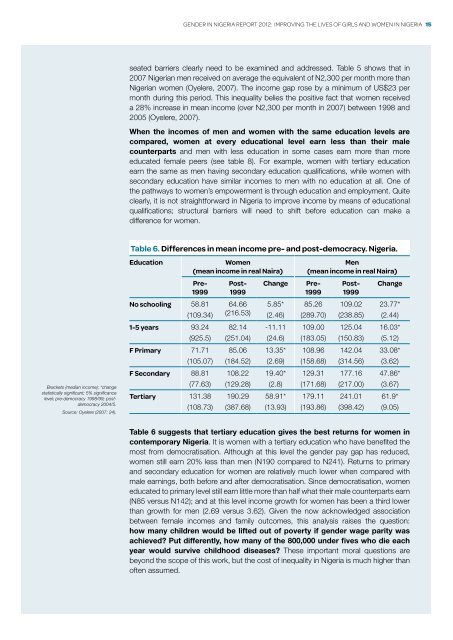Gender in niGeria report 2012 - Economic Commission for Africa
Gender in niGeria report 2012 - Economic Commission for Africa
Gender in niGeria report 2012 - Economic Commission for Africa
Create successful ePaper yourself
Turn your PDF publications into a flip-book with our unique Google optimized e-Paper software.
<strong>Gender</strong> <strong>in</strong> Nigeria Report <strong>2012</strong>: Improv<strong>in</strong>g the Lives of Girls and Women <strong>in</strong> Nigeria 15<br />
seated barriers clearly need to be exam<strong>in</strong>ed and addressed. Table 5 shows that <strong>in</strong><br />
2007 Nigerian men received on average the equivalent of N2,300 per month more than<br />
Nigerian women (Oyelere, 2007). The <strong>in</strong>come gap rose by a m<strong>in</strong>imum of US$23 per<br />
month dur<strong>in</strong>g this period. This <strong>in</strong>equality belies the positive fact that women received<br />
a 28% <strong>in</strong>crease <strong>in</strong> mean <strong>in</strong>come (over N2,300 per month <strong>in</strong> 2007) between 1998 and<br />
2005 (Oyelere, 2007).<br />
When the <strong>in</strong>comes of men and women with the same education levels are<br />
compared, women at every educational level earn less than their male<br />
counterparts and men with less education <strong>in</strong> some cases earn more than more<br />
educated female peers (see table 8). For example, women with tertiary education<br />
earn the same as men hav<strong>in</strong>g secondary education qualifications, while women with<br />
secondary education have similar <strong>in</strong>comes to men with no education at all. One of<br />
the pathways to women’s empowerment is through education and employment. Quite<br />
clearly, it is not straight<strong>for</strong>ward <strong>in</strong> Nigeria to improve <strong>in</strong>come by means of educational<br />
qualifications; structural barriers will need to shift be<strong>for</strong>e education can make a<br />
difference <strong>for</strong> women.<br />
Table 6. Differences <strong>in</strong> mean <strong>in</strong>come pre- and post-democracy. Nigeria.<br />
Brackets (median <strong>in</strong>come); *change<br />
statistically significant; 5% significance<br />
level; pre-democracy 1998/99; postdemocracy<br />
2004/5.<br />
Source: Oyelere (2007: 24).<br />
Education<br />
Pre-<br />
1999<br />
No school<strong>in</strong>g 58.81<br />
(109.34)<br />
1-5 years 93.24<br />
(925.5)<br />
F Primary 71.71<br />
(105.07)<br />
F Secondary 88.81<br />
(77.63)<br />
Tertiary 131.38<br />
(108.73)<br />
Women<br />
(mean <strong>in</strong>come <strong>in</strong> real Naira)<br />
Post-<br />
1999<br />
64.66<br />
(216.53)<br />
82.14<br />
(251.04)<br />
85.06<br />
(184.52)<br />
108.22<br />
(129.28)<br />
190.29<br />
(387.68)<br />
Change<br />
5.85*<br />
(2.46)<br />
-11.11<br />
(24.6)<br />
13.35*<br />
(2.69)<br />
19.40*<br />
(2.8)<br />
58.91*<br />
(13.93)<br />
Men<br />
(mean <strong>in</strong>come <strong>in</strong> real Naira)<br />
Pre-<br />
1999<br />
85.26<br />
(289.70)<br />
109.00<br />
(183.05)<br />
108.96<br />
(158.68)<br />
129.31<br />
(171.68)<br />
179.11<br />
(193.86)<br />
Post-<br />
1999<br />
109.02<br />
(238.85)<br />
125.04<br />
(150.83)<br />
142.04<br />
(314.56)<br />
177.16<br />
(217.00)<br />
241.01<br />
(398.42)<br />
Change<br />
23.77*<br />
(2.44)<br />
16.03*<br />
(5.12)<br />
33.08*<br />
(3.62)<br />
47.86*<br />
(3.67)<br />
61.9*<br />
(9.05)<br />
Table 6 suggests that tertiary education gives the best returns <strong>for</strong> women <strong>in</strong><br />
contemporary Nigeria. It is women with a tertiary education who have benefited the<br />
most from democratisation. Although at this level the gender pay gap has reduced,<br />
women still earn 20% less than men (N190 compared to N241). Returns to primary<br />
and secondary education <strong>for</strong> women are relatively much lower when compared with<br />
male earn<strong>in</strong>gs, both be<strong>for</strong>e and after democratisation. S<strong>in</strong>ce democratisation, women<br />
educated to primary level still earn little more than half what their male counterparts earn<br />
(N85 versus N142); and at this level <strong>in</strong>come growth <strong>for</strong> women has been a third lower<br />
than growth <strong>for</strong> men (2.69 versus 3.62). Given the now acknowledged association<br />
between female <strong>in</strong>comes and family outcomes, this analysis raises the question:<br />
how many children would be lifted out of poverty if gender wage parity was<br />
achieved? Put differently, how many of the 800,000 under fives who die each<br />
year would survive childhood diseases? These important moral questions are<br />
beyond the scope of this work, but the cost of <strong>in</strong>equality <strong>in</strong> Nigeria is much higher than<br />
often assumed.

















